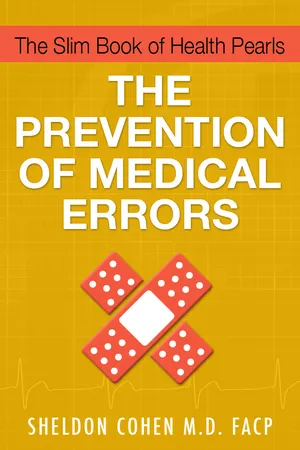
This is a test
- 44 pages
- English
- ePUB (mobile friendly)
- Available on iOS & Android
eBook - ePub
The Slim Book of Health Pearls: The Prevention of Medical Errors
Book details
Book preview
Table of contents
Citations
About This Book
A medical error occurs when a healthcare provider chooses an improper method of care, or inappropriately executes a correct method of care. Medical errors result in death and disability. More often than not, the medical error results from a system failure, a lack of coordination amongst those responsible for delivering patient care. The Institute of Medicine estimates between 44,000 to 98,000 deaths per year result from medical errors.
Frequently asked questions
At the moment all of our mobile-responsive ePub books are available to download via the app. Most of our PDFs are also available to download and we're working on making the final remaining ones downloadable now. Learn more here.
Both plans give you full access to the library and all of Perlego’s features. The only differences are the price and subscription period: With the annual plan you’ll save around 30% compared to 12 months on the monthly plan.
We are an online textbook subscription service, where you can get access to an entire online library for less than the price of a single book per month. With over 1 million books across 1000+ topics, we’ve got you covered! Learn more here.
Look out for the read-aloud symbol on your next book to see if you can listen to it. The read-aloud tool reads text aloud for you, highlighting the text as it is being read. You can pause it, speed it up and slow it down. Learn more here.
Yes, you can access The Slim Book of Health Pearls: The Prevention of Medical Errors by Sheldon Cohen M.D. in PDF and/or ePUB format, as well as other popular books in Medicine & Health Care Delivery. We have over one million books available in our catalogue for you to explore.
Information
Publisher
eBookIt.comISBN
9781456607487
Topic
MedicineSubtopic
Health Care DeliveryIntroduction
“Es Irrt Der Mensch, So Lang Er Strebt”
(As long as human beings strive, they will make errors)
Johann Wolfgang von Goethe
(1749-1832)
A medical error has occurred anytime a healthcare provider plans a medical action and it does not succeed as intended, or the wrong plan is used. These errors can include problems in medical practice, failure to diagnose, procedural problems, system failures, or product deficiencies.
Ninety-eight thousand people per year die from medical errors, a number that represents more deaths than occur from automobile accidents or breast cancer. This statistic, published by the Institute of Medicine in 1999, has prompted efforts by the Joint Commission on Accreditation of Healthcare Organizations to focus the accreditation process on operational systems critical to the safety and quality of patient care.
What is the Institute of Medicine? Who are its members? Are they a governmental organization? What is the funding source?
The federal government created the National Academy of Sciences to serve as an advisor on scientific matters. However, the Academy and its associated organization (e.g. the Institute of Medicine) is a private, non-governmental organization that does not receive direct federal appropriations for their work. The Institute of Medicine’s charter establishes it as an independent body. They use unpaid volunteer experts who author their reports, each of which undergoes a rigorous and formal peer review process that must be evidence-based where possible, or noted as an expert opinion where not possible. Many meetings of the Institute of Medicine are open to the public, or the committee may deliberate amongst themselves until they reach consensus. Any potential conflict of interest could disqualify a committee member.
One cannot dispute this committee’s findings—the best minds are at work. In addition, the Joint Commission considered it serious as well, for they have launched a nationwide effort to minimize medical errors in healthcare organizations.
Let us define what medical errors are. The Joint Commission has categorized a long list of hospital errors that have resulted in death or injury, the so-called sentinel events. This is necessary so that the Joint Commission can investigate and make sure that hospitals have put systems in place to prevent the error from reoccurring. These sentinel events are:
•Anesthesia related: death or injury may result from anesthesia.
•Delay in treatment: failure to diagnose in time, treatment delays resulting in disability or death and wrong diagnoses are all medical errors. An incomplete medical examination is often the reason.
•Elopement: serious injury or death could result when patients leaves facilities of their own accord before diagnosis.
•Infection-related: lapses in sterile technique may result in an infection.
•Maternal deaths: obstetrical deliveries may result in injury or death.
•Medical equipment: medical equipment failures may result in disability or death.
•Medication error: physician, pharmacist, or patient error may result in injury or death due to improper or wrong medication use.
•Operative/post-operative: complications may result from surgical or post surgical care.
•Patient abduction: infant abduction from newborn nurseries have occurred.
•Patient falls: the failure to identify the fall-risk patient, and/or the failure to safeguard the patient may have serious consequences.
•Perinatal deaths/injury:in...
Table of contents
- eBook Cover
- Title Page
- Introduction
- Medication prescribing and use
- Medication use during care transitions
- Patient identification
- Performance of correct procedure at correct body site
- Communication failures during patient handovers
- Control of concentrated electrolyte solutions
- Catheter and tubing connections
- Infection control
- Diagnostic errors and failure to diagnose